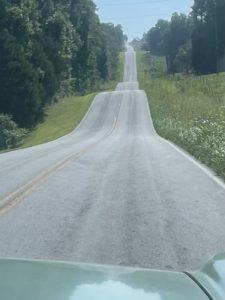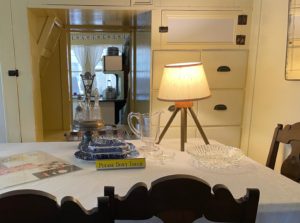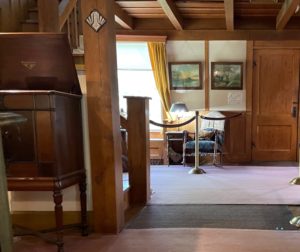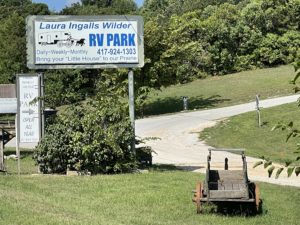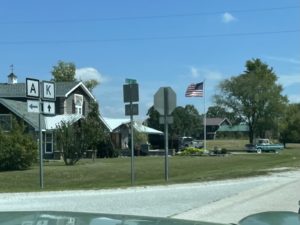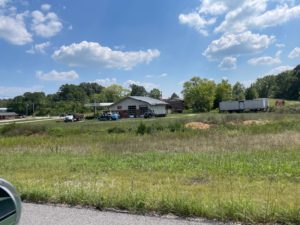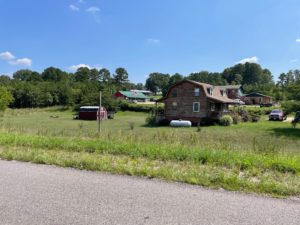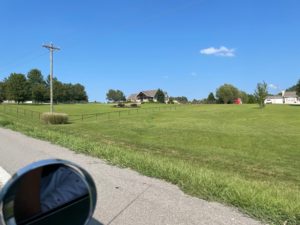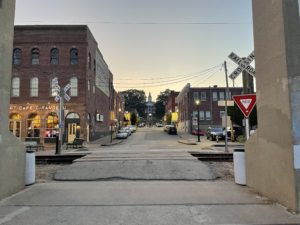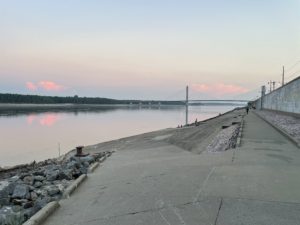In which Sid and Doris see two Laura Ingalls Wilders’ homes and arrive on the Mississippi.

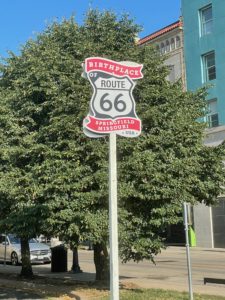 We leave Springfield via a Route 66 photo opportunity. Our route only crosses the 66 rather than running along it because the 66 has a rather unusual NE-SW route from Chicago to Springfield and then due west to the Pacific. So we photograph ourselves on the Kink To End All Kinks and then turn right.
We leave Springfield via a Route 66 photo opportunity. Our route only crosses the 66 rather than running along it because the 66 has a rather unusual NE-SW route from Chicago to Springfield and then due west to the Pacific. So we photograph ourselves on the Kink To End All Kinks and then turn right.
We are on our way to Cape Girardeau via two homes of Laura Ingalls Wilder (1867 to 1957) who wrote Little House on the Prairie and other children’s books based on her childhood in a pioneer family. She was born in the Big Woods area of Wisconsin and her first book in 1932 was Little House in the Big Woods. For the full story see Pulitzer Prize winning Prairie Fires: The American Dreams of Laura Ingalls Wilder by Caroline Fraser, or the Wiki pages (please give money to Wiki). Her first job, at 16, was class teacher in a one room school and married at 18 was relieved to relinquish the job.
We are going to see the houses at Rocky Ridge near Mansfield, Missouri where Laura and her husband Almanzo Wilder farmed and built a home. Laura started writing local colour pieces for The Missouri Ruralist in 1911 but did not get a book accepted until 1932. The depression was not a great time for the book trade though royalties were a useful contribution to the farm income, especially as all non-farm capital had been lost in the 1929 crash. The real money did not come until the TV shows after her death and Wiki can tell you about the fight over the rights, though the books are out of copyright.
But first the obligatory gosh-aren’t-these-roads-straight photographs, and also another picture of Road Naming And Numbering Failure.
 Oh, and an opportunity to share a fuel pump with another old-timer.
Oh, and an opportunity to share a fuel pump with another old-timer.
Our first visit is to the museum in Mansfield which has a timeline of her many travels as a child and thousands of items from The Life, such as her Pa’s fiddle.
There is a small amount of local exploitation of The Great One, but not much.
While we are there a militant model railway fan engages Sid in conversation. He tells Sid much about the business of collecting, trading and building Marx O gauge layouts. It seems to be quite an affliction requiring constant acquisition and much technical knowledge. So his wife’s support for building a new building separate from their house to hold his layout is quite understandable.
 We walk out to see the Ingalls Wilders’ first house with a dozen or so other Prairie fans, mainly little women (a slightly anachronistic allusion). Our host takes us through in the order the rooms were built, making up a pleasant little house with gradually larger and more sophisticated spaces as the budget for the build increased.
We walk out to see the Ingalls Wilders’ first house with a dozen or so other Prairie fans, mainly little women (a slightly anachronistic allusion). Our host takes us through in the order the rooms were built, making up a pleasant little house with gradually larger and more sophisticated spaces as the budget for the build increased.
 The second home was a gift from her daughter who post WW1 was working in Albania for the US Red Cross. The house was from the Sears Roebuck catalogue (from which Americans could buy anything, including a house). Rather than accepting the materials Sears would send she engaged an architect to take the plan, make some additions and ensure that it was well built and that it would be a stone cottage as found in England. She succeeded in the first objectives. It is charming and practical, but in the end Laura and Almanzo Wilder moved back to the house they built.
The second home was a gift from her daughter who post WW1 was working in Albania for the US Red Cross. The house was from the Sears Roebuck catalogue (from which Americans could buy anything, including a house). Rather than accepting the materials Sears would send she engaged an architect to take the plan, make some additions and ensure that it was well built and that it would be a stone cottage as found in England. She succeeded in the first objectives. It is charming and practical, but in the end Laura and Almanzo Wilder moved back to the house they built.
We leave Mansfield past a low-key attempt to exploit the links with The Great One and go along the old Route 60 until we need more ground covered and get onto the new 60.with
Doris takes pictures as we go along, trying to capture the way that the houses seem to be lazily spread out with so much space in between them. Very different from the UK pattern of houses built mainly around villages/towns and all space rigorously fenced off – perhaps a legacy of the Enclosures Acts. It gets lusher, greener, and more trees with each mile we pass.
We try to stop at non-chain places. Lunch was taken at Kapps Country Kitchen. The food was good and the dining room interestingly full of local produce. We passed on the gun raffle.
Cape Girardeau is north of the ‘as the bat flies’ line from Springfield to Nashville but does have places to stay and excitingly for travelers is on the Mississippi. It was not French for long, soon ceded to the Spanish after the Seven Years’ War. With the coming of the steamboat in 1835 the town was a significant port. When Sid and Doris went down to the river there was no sign of a dock now and the bollards are a long way from the water – although there are also some very serious flood defences implying that the river gets much, much higher than it is now.
There was a ferry here until a bridge was built across to Illinois in 1928, superseded by a higher, wider, stronger bridge in 2003 to take the JGG tomorrow.
Whoo-hee! We’ve got to the Miss Iss Ippi!!! We celebrate with dinner in the Port Cape Girardeau Restaurant and Lounge, a venue which was once used as an office by Ulysses S Grant and now seems to be used as a home-from-home for many middle-aged baseball-loving Girardeauians (a word we made up but which could be very useful in Scrabble).

